Understanding How Early Nutrition Influences Autism Spectrum Disorder
Recent studies have illuminated the protective influence of breastfeeding against autism spectrum disorder (ASD). This article explores the evidence demonstrating how breastfeeding duration plays a significant role in reducing the risk of ASD, the interplay with maternal prenatal education, and the implications for early interventions like Applied Behavior Analysis (ABA) therapy.
Breastfeeding and Its Protective Impact on Autism Risk
What is the protective effect of breastfeeding on autism risk?
Extensive research indicates that breastfeeding offers a protective effect against the development of autism spectrum disorder (ASD). Children who are exclusively breastfed exhibit the lowest risk of ASD compared to those who are not. This protective influence is believed to stem from the nutritional and immunological benefits provided by breast milk during critical periods of brain development.
How does breastfeeding duration affect autism risk reduction?
The reduction in autism risk is dose-dependent, meaning the longer the duration of breastfeeding, the greater the protective benefit. This relationship demonstrates a clear trend where extended breastfeeding correlates with continuously lowering the likelihood of ASD.
What are the statistics on risk reduction with different breastfeeding durations?
Breastfeeding for about 6 months is associated with a significant 54% reduction in the risk of autism. Moreover, when breastfeeding continues for 12 to 24 months, the reduction in risk becomes even more pronounced. Specifically, the odds ratio for developing ASD in this group is 0.23, with a 95% confidence interval ranging from 0.14 to 0.36. This means children breastfed for one to two years are about 77% less likely to develop ASD compared to non-breastfed children.
These findings highlight the importance of supporting and encouraging breastfeeding for at least the first six months, with continued breastfeeding up to two years or beyond providing the most significant protective effects against autism.
| Breastfeeding Duration | Approximate ASD Risk Reduction | Additional Notes |
|---|---|---|
| Exclusive breastfeeding | Lowest risk | Strongest protective effect observed |
| Around 6 months | 54% reduction | Significant early protective benefit |
| 12 to 24 months | 77% reduction (OR = 0.23) | Most significant reduction; strong statistical evidence |
Duration Matters: How Long-Term Breastfeeding Reduces ASD Risk
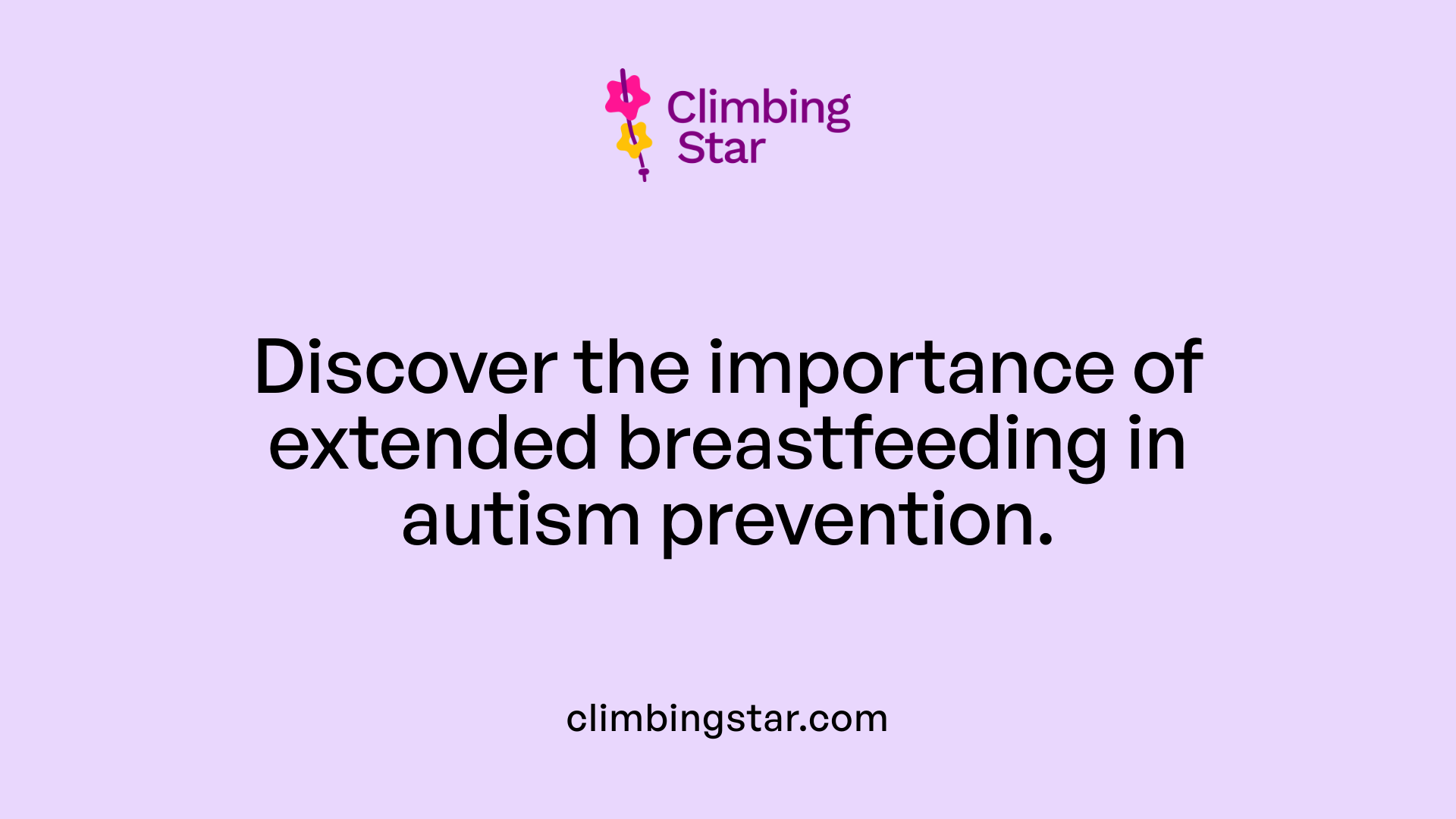
How does the duration of breastfeeding affect autism risk?
Breastfeeding plays a significant role in reducing the risk of autism spectrum disorder (ASD), and importantly, the duration of breastfeeding directly influences this protective effect. Studies show that breastfeeding for approximately six months is associated with a 54% reduction in the risk of developing ASD. This suggests that even moderate periods of exclusive breastfeeding can offer substantial benefits.
Extending breastfeeding beyond six months further enhances this protective effect. Breastfeeding for 12 to 24 months is linked to the most considerable reduction in ASD risk, with an odds ratio of 0.23 (95% confidence interval: 0.14 to 0.36). This means children breastfed for up to two years are much less likely to exhibit signs of ASD compared to those who are not breastfed or breastfed for shorter periods.
This relationship highlights a clear dose-dependent effect where the longer the breastfeeding duration, the greater the reduction in autism risk. The evidence points to the importance of encouraging long-term breastfeeding as a preventative strategy against ASD, reinforcing the idea that sustained breastfeeding yields the most significant benefits.
Exclusive Breastfeeding and Autism: Why Exclusivity Counts
Does exclusive breastfeeding influence autism risk differently?
Exclusive breastfeeding plays a crucial role in reducing the risk of autism spectrum disorder (ASD). Exclusive breastfeeding means the infant receives only breast milk, without any supplementary foods or formula.
Research indicates that infants who are exclusively breastfed have a lower risk of developing ASD compared to those who are partially breastfed or not breastfed at all. This exclusivity appears to enhance the protective effect of breastfeeding on neurological development.
The protective influence is dose-dependent, meaning the more exclusive and longer the breastfeeding period, the greater the reduction in ASD risk. For example, exclusively breastfed infants for around six months have a notable risk reduction, and the greatest risk decrease occurs with extended breastfeeding durations.
By favoring exclusive breastfeeding, mothers may help reduce their child's chances of exhibiting autistic-like behaviors later in preschool years, underlining its importance as a preventive measure against ASD.
Understanding Autistic-Like Behaviors in Preschoolers and Breastfeeding
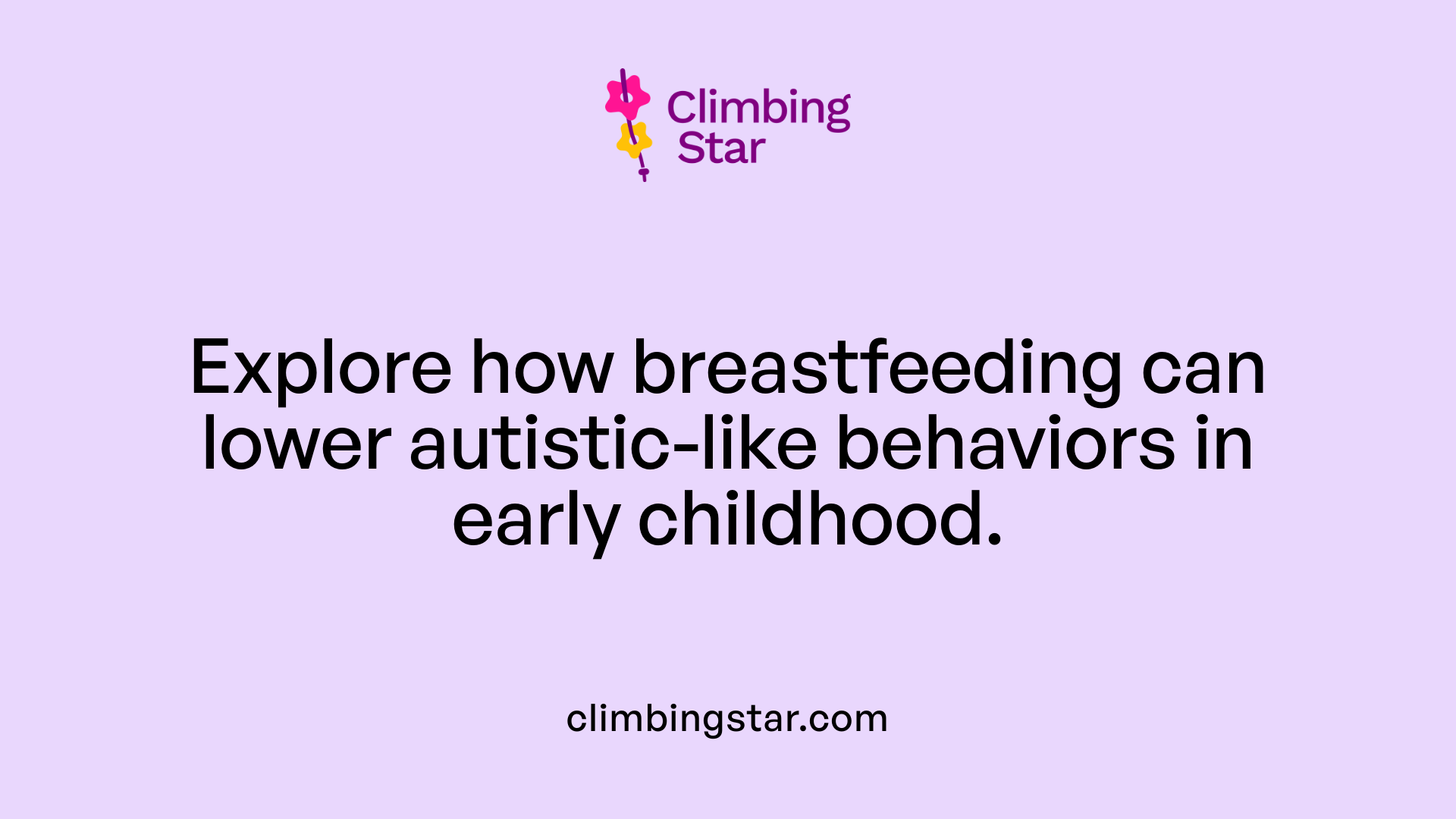
Does breastfeeding impact autistic-like behaviors in early childhood?
Breastfeeding has been found to have a protective impact against autistic-like behaviors in preschool children. Studies show that children who were breastfed display a significantly lower presence of these behaviors. Specifically, the odds ratio (OR) for autistic-like behaviors among breastfed children is 0.773. This means breastfeeding reduces the likelihood of exhibiting such behaviors by approximately 23% compared to children who were not breastfed.
How does breastfeeding influence autistic-like behaviors?
The protective effect of breastfeeding is thought to be linked to the nutrients and antibodies it provides, as well as the physical closeness it fosters between mother and child. These factors may contribute to healthier brain development and social behaviors in early childhood.
Moreover, maternal participation in prenatal education, which promotes breastfeeding, further decreases the risk of autistic-like behaviors. Prenatal education helps mothers understand the benefits of breastfeeding, leading to higher breastfeeding rates and durations. Importantly, breastfeeding partially mediates the link between maternal prenatal education and reduced autistic-like behaviors, accounting for about 14.3% of the protective effect.
Combined effects of breastfeeding and prenatal education
Children whose mothers participated in prenatal education and practiced breastfeeding have the lowest risk of autistic-like behaviors. The odds ratio for this group is 0.569, indicating a strong additive protective benefit when both factors are present.
This evidence supports encouraging breastfeeding and prenatal education as critical strategies to help lower the risk of autistic-like behaviors in preschool-aged children.
The Role of Maternal Prenatal Education in Reducing Autism Risk
Impact of prenatal education on breastfeeding likelihood
Maternal participation in prenatal education plays a significant role in promoting breastfeeding. Studies show that mothers who engage in prenatal education are more likely to breastfeed their infants. This association strengthens with the frequency of prenatal education visits, with odds ratios (ORs) ranging from 1.191 to 1.899. In other words, regular prenatal classes and counseling considerably increase the chances of mothers choosing to breastfeed, which is crucial in reducing autism spectrum disorder (ASD) risk.
Effect of prenatal education on autistic-like behaviors
Prenatal education not only encourages breastfeeding but also directly relates to lower risks of autistic-like behaviors in preschool-aged children. The odds ratios for reduced autistic-like behaviors among children whose mothers participated in prenatal education range between 0.732 and 0.798, highlighting a consistent protective effect. Importantly, breastfeeding partially mediates this association, accounting for about 14.3% of the reduction in autistic-like behaviors.
When maternal prenatal education and breastfeeding coexist, their protective effects combine, resulting in children having the lowest risk of autistic-like behaviors with an OR of 0.569. This suggests that prenatal education enhances breastfeeding rates, which in turn reduces ASD risk, while also independently contributing to developmental benefits.
Overall, the evidence underscores the importance of supporting maternal prenatal education programs as a strategy to promote breastfeeding and thereby reduce autism risk and autistic-like behaviors in children.
Synergistic Effects: Prenatal Education Plus Breastfeeding
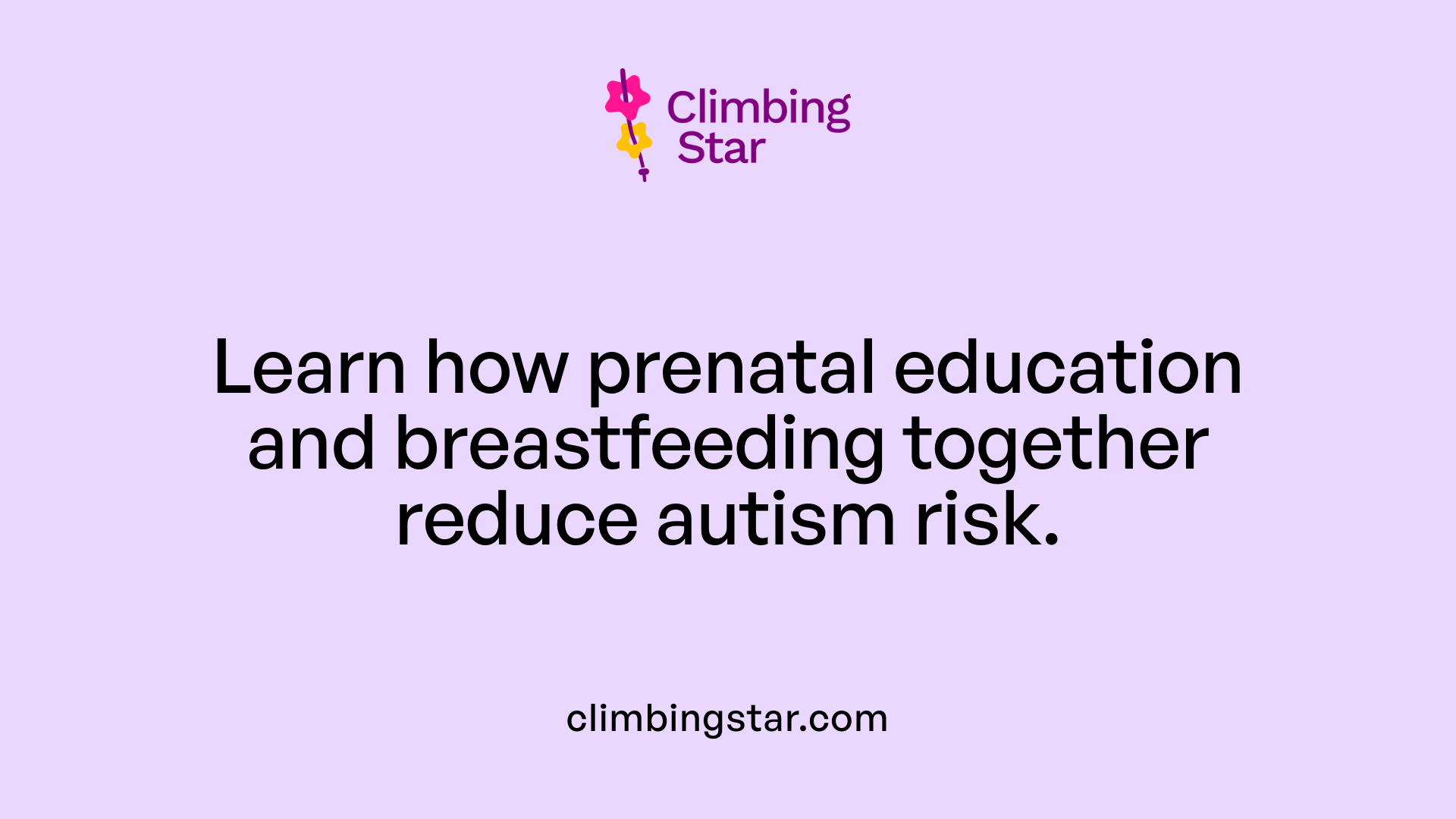
How do prenatal education and breastfeeding work together to reduce autistic-like behaviors?
Maternal participation in prenatal education programs is significantly linked with a decreased risk of autistic-like behaviors in preschool children. The odds ratios for this association range from 0.732 to 0.798, depending on the level of prenatal education engagement. One important mechanism behind this protective effect is breastfeeding, which partially mediates the relationship between prenatal education and autism risk. Specifically, about 14.3% of the reduction in autistic-like behaviors can be attributed to breastfeeding influenced by prenatal education.
Prenatal education encourages and supports mothers in initiating and maintaining breastfeeding. As breastfeeding itself has a protective role against autism spectrum disorder, acting in a dose-dependent manner where longer durations correlate with greater risk reduction, greater engagement in prenatal education can enhance these benefits.
Moreover, when children benefit from both maternal prenatal education and breastfeeding, the protective effects appear to be additive. This combination results in the lowest risk of autistic-like behaviors, with an odds ratio of 0.569. It highlights the synergistic relationship whereby prenatal education increases breastfeeding rates, and together they strongly reduce autism spectrum disorder risks.
In summary, prenatal education and breastfeeding work in tandem: prenatal education promotes breastfeeding, which in turn decreases the likelihood of autistic-like behaviors. The dual approach leverages both direct and indirect pathways to reduce autism risk in early childhood.
Applied Behavior Analysis (ABA) Therapy: An Overview
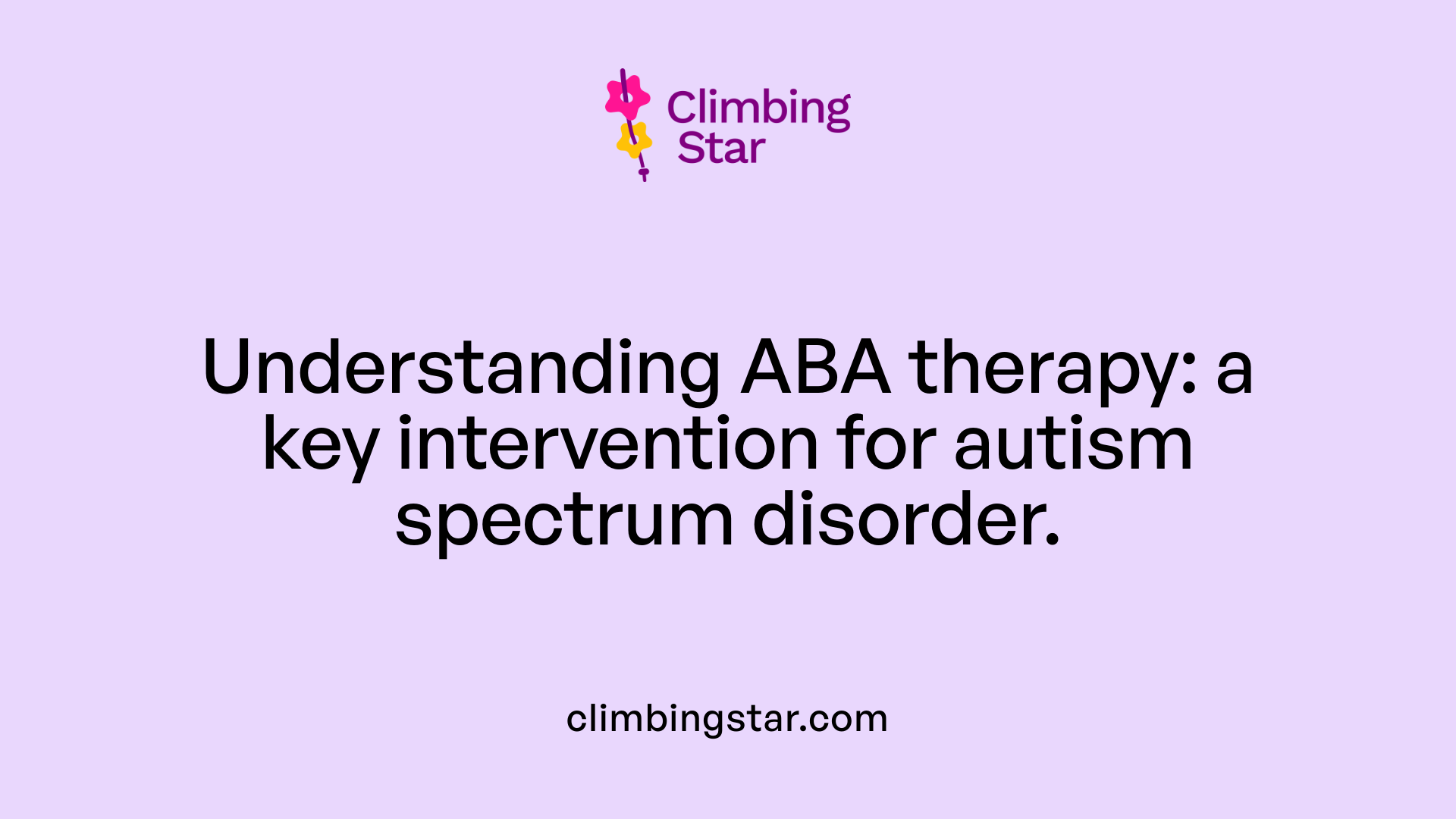
What effect does breastfeeding have on the risk of autism spectrum disorder (ASD)?
Breastfeeding plays a protective role against the risk of ASD. Studies indicate that children who are breastfed show a significantly reduced likelihood of developing autism spectrum disorders.
Does the duration of breastfeeding matter?
Yes, the protective effect of breastfeeding is dose-dependent. Longer breastfeeding durations correlate with greater reductions in ASD risk. For example, exclusive breastfeeding for about 6 months is associated with a 54% reduction in ASD risk. Even more striking, breastfeeding for 12 to 24 months is linked to the most substantial protection, with an odds ratio of 0.23 (95% confidence interval: 0.14 to 0.36), indicating a strong decrease in odds of ASD.
How is maternal prenatal education related to breastfeeding and ASD risk?
Maternal participation in prenatal education significantly increases the likelihood of breastfeeding. Furthermore, the more frequent the prenatal education visits, the stronger this association becomes, with odds ratios ranging from 1.191 to 1.899. Beyond breastfeeding, prenatal education directly contributes to lowering the risk of autistic-like behaviors in preschool children, showing odds ratios between 0.732 and 0.798 depending on participation level.
Is there a combined effect of breastfeeding and prenatal education?
Yes, children whose mothers participate in prenatal education and also breastfeed have the lowest risk of autistic-like behaviors, with an odds ratio of 0.569. Breastfeeding partially mediates this protective effect, accounting for approximately 14.3% of the influence from maternal prenatal education on reducing autistic-like behaviors.
Taken together, these findings underscore the important roles both breastfeeding and prenatal education play in diminishing autism risk, suggesting that supporting mothers through education and encouraging sustained breastfeeding can be effective strategies for lowering ASD susceptibility in children.
Benefits of ABA Therapy for Autism Spectrum Disorder
How Does Breastfeeding Influence the Risk of Autism Spectrum Disorder?
Breastfeeding has been shown to offer significant protection against the development of autism spectrum disorder (ASD). This protective effect is dose-dependent, meaning the longer the duration of breastfeeding, the greater the reduction in ASD risk.
What Duration of Breastfeeding Provides the Greatest Benefit?
Exclusive breastfeeding is associated with the lowest risk of ASD. Specifically, breastfeeding for about 6 months results in an impressive 54% reduction in ASD risk. Extending breastfeeding to between 12 and 24 months confers the most substantial benefit, with studies showing an odds ratio of 0.23 (95% confidence interval: 0.14–0.36), indicating a strong protective effect.
How Does Maternal Prenatal Education Impact Breastfeeding and ASD Risk?
Mothers who engage in prenatal education are more likely to breastfeed, with this likelihood increasing alongside the frequency of education sessions (odds ratios range from 1.191 to 1.899). Furthermore, maternal participation in prenatal education significantly reduces the risk of autistic-like behaviors in preschool children, reflecting odds ratios between 0.732 and 0.798 depending on the level of participation.
What Is the Combined Effect of Prenatal Education and Breastfeeding?
Breastfeeding partially mediates the relationship between maternal prenatal education and the presence of autistic-like behaviors, accounting for roughly 14.3% of this effect. Children whose mothers both participated in prenatal education and breastfed demonstrate the lowest risk of autistic-like behaviors, with an odds ratio of 0.569. This suggests an additive protective benefit when both factors are present.
These findings highlight the critical role of supporting breastfeeding and prenatal education programs to reduce the risk of ASD and related behaviors in children.
Providers of ABA Therapy Services
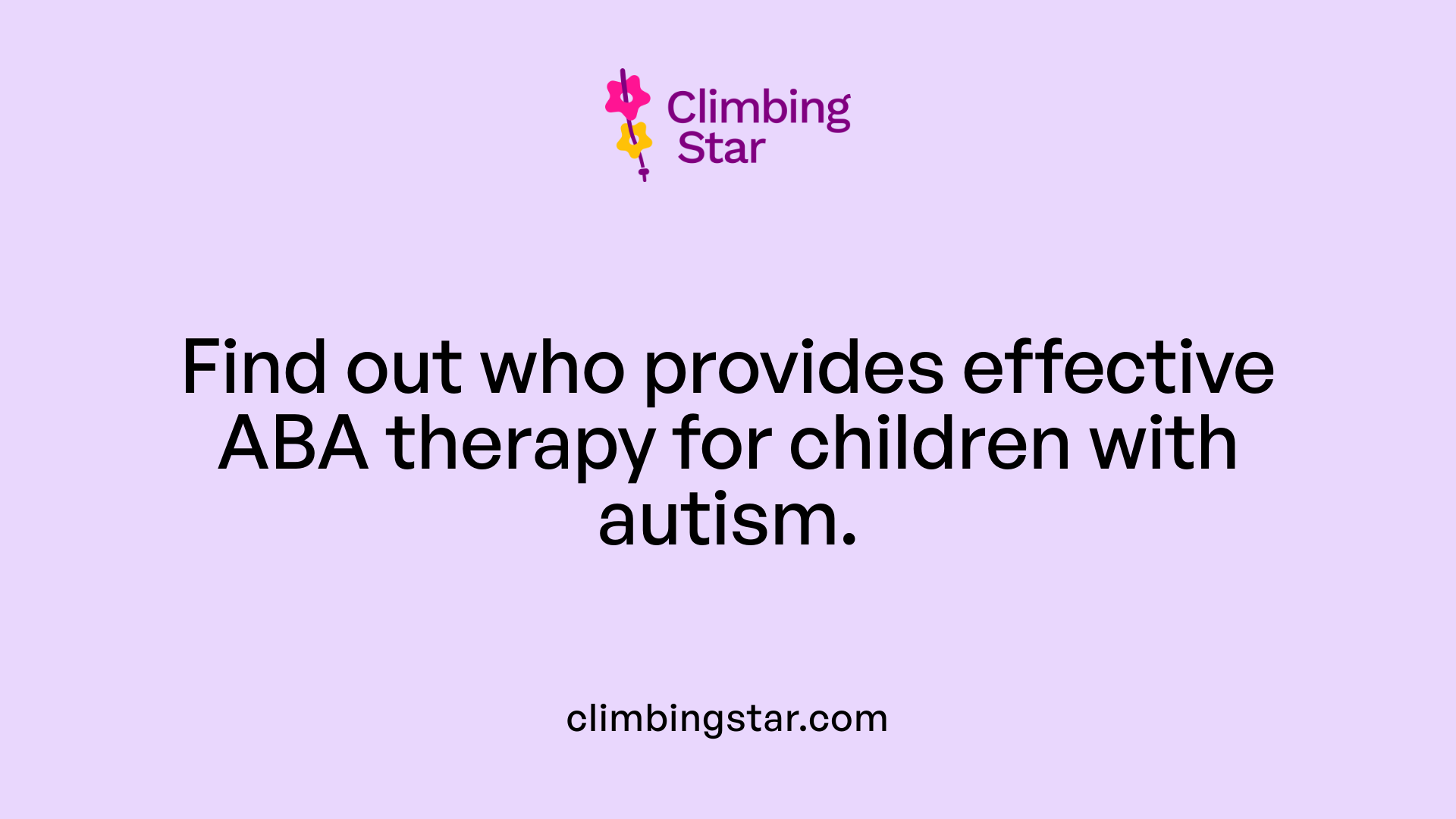
Qualifications of ABA providers
ABA therapy services are offered by professionals who have undergone specific training and certification in applied behavior analysis. The most recognized qualification is the Board Certified Behavior Analyst (BCBA), a credential that requires a master's degree, supervised experience, and passing a certification exam. In addition, Registered Behavior Technicians (RBTs) provide direct therapy under the guidance of BCBAs.
Types of professionals involved
The provision of ABA therapy involves a team approach. BCBAs design and oversee intervention plans, while RBTs implement the therapy sessions with children. Other professionals such as clinical supervisors, speech therapists, occupational therapists, and psychologists may collaborate in delivering a comprehensive treatment plan tailored to the individual needs of clients with autism spectrum disorder.
Accessing ABA therapy services
Families seeking ABA therapy often start by consulting pediatricians or developmental specialists who can provide referrals. Services are usually available through specialized clinics, private practices, and behavioral health companies focusing on autism support. Insurance coverage varies, so it is important for families to verify the benefits available to them. Early intervention providers and regional autism centers also serve as important access points for ABA therapy.
| Provider Type | Role | Requirements |
|---|---|---|
| Board Certified Behavior Analyst (BCBA) | Designs and supervises treatment plans | Master's degree, certification exam |
| Registered Behavior Technician (RBT) | Delivers therapy under supervision | Training and competency assessment |
| Clinical Supervisors | Oversee therapy quality and staff | Relevant clinical licensure |
Overall, qualified ABA providers are essential for effective therapy outcomes, and families are encouraged to explore local resources and educate themselves on available services to support children with autism spectrum disorder.
Common Techniques Used in ABA Therapy
How Does Breastfeeding Influence Autism Spectrum Disorder Risk?
Research shows breastfeeding offers a protective effect against autism spectrum disorder (ASD). Exclusive breastfeeding, in particular, is linked to the lowest risk of ASD, indicating its importance in early child development.
What Role Does Duration of Breastfeeding Play?
The protective effect of breastfeeding is dose-dependent, meaning the longer a child is breastfed, the greater the reduction in ASD risk.
- About 6 months of breastfeeding is associated with a 54% reduction in ASD risk.
- Breastfeeding for 12 to 24 months provides the most significant reduction, with an odds ratio of 0.23, reflecting a strong protective benefit.
How Does Maternal Prenatal Education Relate to Breastfeeding and ASD Risk?
Maternal participation in prenatal education greatly increases the likelihood of breastfeeding, with the effect growing stronger with more frequent prenatal visits (odds ratios ranging from 1.191 to 1.899). This participation also lowers the chances of autistic-like behaviors in preschoolers, with odds ratios between 0.732 and 0.798.
Can Breastfeeding Mediate the Effect of Prenatal Education on Autistic Behaviors?
Yes, breastfeeding partially mediates the beneficial effects of maternal prenatal education on reducing autistic-like behaviors, accounting for approximately 14.3% of this effect.
What Is the Combined Impact of Prenatal Education and Breastfeeding?
Children whose mothers engaged in prenatal education and breastfed enjoy the lowest risk of autistic-like behaviors (odds ratio = 0.569), suggesting a stronger combined protective effect.
| Factor | Impact on ASD Risk | Notes |
|---|---|---|
| Exclusive Breastfeeding | Lowest ASD risk | Most protective among feeding types |
| Breastfeeding 6 months | 54% risk reduction | Significant early benefit |
| Breastfeeding 12–24 months | Odds ratio 0.23 (strongest effect) | Long-term breastfeeding maximizes protection |
| Maternal Prenatal Education | Increases breastfeeding likelihood | More visits correlate with higher breastfeeding rates |
| Prenatal Education & ASD Risk | Reduced autistic-like behaviors | ORs from 0.732 to 0.798 |
| Breastfeeding Mediation | Mediates 14.3% of education effect | Indicates partial pathway of ASD risk reduction |
| Combined Breastfeeding & Education | Lowest autistic-like behavior risk | OR 0.569 shows additive protective effect |
Suitability of ABA Therapy for Different Individuals with Autism
What is the relationship between breastfeeding and autism spectrum disorder (ASD)?
Breastfeeding has been found to have a protective effect against the risk of developing autism spectrum disorder (ASD). Notably, exclusive breastfeeding is associated with the lowest risk. The longer the duration of breastfeeding, the greater the reduction in ASD risk, indicating a dose-dependent relationship. For example, breastfeeding for about 6 months can reduce the risk of ASD by 54%, showcasing a substantial protective benefit.
How does breastfeeding duration impact the reduction of ASD risk?
Extended breastfeeding offers increasing protection. Breastfeeding for 12 to 24 months correlates with the most significant decrease in ASD risk. The odds ratio for this duration is 0.23 (95% confidence interval: 0.14–0.36), indicating that children breastfed in this range have substantially lower odds of developing ASD compared to those who are not breastfed or breastfed for shorter periods.
What role does maternal prenatal education play in breastfeeding and autism risk?
Maternal participation in prenatal education significantly improves the likelihood of breastfeeding. Increased frequency of prenatal educational visits strengthens this association, with odds ratios ranging from 1.191 to 1.899. Furthermore, prenatal education itself is linked with a reduced risk of autistic-like behaviors in preschool children, with odds ratios between 0.732 and 0.798, depending on the level of participation.
Does breastfeeding mediate the effects of prenatal education on autistic-like behaviors?
Breastfeeding partially mediates the influence of maternal prenatal education on autistic-like behaviors, accounting for about 14.3% of the observed effect. This means that part of the benefit from prenatal education on reducing autistic-like behaviors in children can be attributed to its positive impact on breastfeeding practices.
Is there an additive protective effect combining prenatal education and breastfeeding?
Children whose mothers both participated in prenatal education and breastfed show the lowest risk of autistic-like behaviors, with an odds ratio of 0.569. This suggests an additive effect, where both factors together provide greater protection against ASD-related behaviors than either alone.
| Factor | Effect on ASD Risk | Additional Notes |
|---|---|---|
| Exclusive breastfeeding | Lowest risk | Reduces risks notably compared to partial or no breastfeeding |
| Breastfeeding duration (6 months) | 54% risk reduction | Important early protection |
| Breastfeeding duration (12–24 mo) | Greatest risk reduction (OR=0.23) | Most significant impact |
| Maternal prenatal education | Increased breastfeeding & reduced autistic-like behaviors | Stronger with more education sessions |
| Combined breastfeeding & education | Lowest risk of autistic-like behaviors (OR=0.569) | Suggests an additive protective effect |
Integrating Early Prevention with Therapeutic Interventions
How Do Breastfeeding and Prenatal Education Influence Autism-Related Outcomes?
Research highlights a compelling connection between breastfeeding, prenatal education, and reduced autism spectrum disorder (ASD) risk. Exclusive breastfeeding, particularly when sustained for 6 to 24 months, is strongly linked to a significant decrease in ASD risk—for example, breastfeeding for around 6 months relates to a 54% reduction, while 12 to 24 months shows even more substantial risk reduction (odds ratio of 0.23).
Moreover, maternal engagement in prenatal education enhances breastfeeding rates, which itself is associated with fewer autistic-like behaviors in preschool children. Prenatal education’s supportive role is evident as it not only encourages breastfeeding but also independently lowers autistic-like behaviors, with odds ratios between 0.732 and 0.798.
What Is the Potential Influence on ABA Therapy Effectiveness?
Considering that breastfeeding and prenatal education reduce autistic-like behaviors and ASD risk, these early preventive factors may prime children for improved outcomes in therapies such as Applied Behavior Analysis (ABA). Children who received both prenatal education and breastfeeding show the lowest risk for autistic-like behaviors (odds ratio of 0.569), suggesting cumulative benefits.
The protective effects potentially contribute to a more favorable baseline, possibly making children more responsive to ABA therapy by mitigating some severity or behavioral challenges associated with autism. Integrating early prevention strategies like breastfeeding promotion and prenatal education into therapeutic planning may thus enhance the effectiveness of ABA and similar interventions, supporting better developmental trajectories.
Continued exploration of how these early-life factors influence treatment responsiveness could foster refined, holistic approaches to autism care, combining prevention and therapy for optimal child outcomes.
The Importance of Early Life Nutrition in Autism Prevention
Why are early developmental periods critical for autism prevention?
Early life, particularly the prenatal phase and first two years after birth, represents a crucial window for brain development. During this time, the brain undergoes rapid growth and neural connections are formed extensively. Nutritional inputs in these stages can profoundly influence neurodevelopmental trajectories, potentially impacting the risk for conditions such as autism spectrum disorder (ASD).
How does breastfeeding affect ASD risk during these critical periods?
Breastfeeding serves as a vital source of nutrition that supports brain growth and immune function. Research shows that breastfeeding has a protective effect against ASD, and this benefit is dose-dependent—the longer the duration of breastfeeding, the greater the reduction in ASD risk.
Exclusive breastfeeding is especially impactful, showing the lowest risk of ASD among infants. Notably, breastfeeding for about 6 months is linked to a 54% reduction in ASD risk. Extending breastfeeding to between 12 and 24 months offers an even more significant protective effect, decreasing the likelihood of ASD with an odds ratio of 0.23 (95% CI: 0.14–0.36).
Overall, breastfeeding not only nourishes infants during their critical developmental phases but also contributes to significantly lowering the chances of autistic-like behaviors in early childhood. This underscores the integral role that breastfeeding plays within early life nutrition as a modifiable factor in autism prevention strategies.
Supporting Mothers: Encouraging Breastfeeding Through Prenatal Education
Strategies to Increase Prenatal Education Participation
Prenatal education plays a crucial role in preparing expectant mothers for breastfeeding. To increase participation, healthcare providers can offer flexible scheduling and multiple session options to accommodate varying availability. Integrating prenatal education into routine prenatal care visits helps ensure more women receive this information. Additionally, promoting the benefits of prenatal education via community outreach and social media campaigns raises awareness and encourages attendance. Offering incentives, such as free breastfeeding supplies or access to lactation consultants for regular attendees, can further motivate participation.
Enhancing Breastfeeding Rates Through Education
Mothers who attend prenatal education classes are more likely to breastfeed, and the likelihood increases with the frequency of visits—odds ratios range from 1.191 to 1.899. Prenatal education provides essential knowledge about breastfeeding techniques, overcoming common challenges, and understanding breastfeeding's protective effects against conditions like autism spectrum disorder (ASD). This knowledge empowers mothers and builds confidence, which contributes to longer breastfeeding durations.
Importantly, exclusive breastfeeding has been linked to the lowest risk of ASD, with protective effects strengthening as the duration of breastfeeding increases. For instance, breastfeeding for about 6 months is associated with a 54% reduction in ASD risk, while breastfeeding for 12–24 months shows the most significant reduction with an odds ratio of 0.23.
Moreover, breastfeeding not only reduces ASD risk but also lowers the presence of autistic-like behaviors in preschool children (OR = 0.773). Prenatal education itself directly decreases the risk of these behaviors (ORs from 0.732 to 0.798). Together, breastfeeding and prenatal education show an additive protective effect, with children experiencing both interventions having the lowest risk (OR = 0.569). Breastfeeding mediates about 14.3% of the positive impact of prenatal education on reducing autistic-like behaviors, highlighting the intertwined benefits.
By encouraging prenatal education as a foundation, healthcare providers can effectively promote breastfeeding initiation and continuation, ultimately supporting better developmental outcomes for children.
Challenges and Considerations in Breastfeeding and Autism Research
What are the limitations of current studies on breastfeeding and autism?
Current research indicates a protective effect of breastfeeding against autism spectrum disorder (ASD), but several limitations must be acknowledged. Many studies rely on observational data, which can introduce biases related to confounding factors such as socioeconomic status, maternal education, and healthcare access. These factors themselves influence the likelihood of breastfeeding and risk for ASD, making it difficult to isolate the effect of breastfeeding alone.
Additionally, variability in how ASD is diagnosed and reported, as well as differences in breastfeeding practices across populations, can further complicate interpretation of results. Most studies focus on exclusive breastfeeding duration but may not fully account for partial breastfeeding or complementary feeding practices.
Why is further research needed on causality and underlying mechanisms?
While longer durations of breastfeeding have been associated with greater reductions in ASD risk, a clear cause-and-effect relationship is yet to be established. To confirm causality, research must move beyond association to investigate biological mechanisms through which breastfeeding might influence neurodevelopment.
Potential pathways include the transfer of essential nutrients and immune factors from mother to infant, which may impact brain development. Understanding how maternal participation in prenatal education enhances breastfeeding rates—and consequently influences ASD outcomes—also requires deeper exploration.
Further studies using rigorous designs like randomized controlled trials, where feasible, and longitudinal approaches can help clarify these mechanisms and the extent to which breastfeeding directly modulates ASD risk. This will improve the evidence base for public health recommendations and prenatal education interventions aimed at reducing autistic-like behaviors through breastfeeding promotion.
Looking Ahead: Implications for Public Health and Autism Prevention
How Can Promoting Breastfeeding and Prenatal Education Help Prevent Autism?
Promoting breastfeeding and prenatal education emerges as a promising approach in reducing the risk of autism spectrum disorder (ASD). Evidence shows that exclusive breastfeeding for about six months can lower the risk of ASD by approximately 54%, with even greater reductions observed when breastfeeding extends to 12–24 months. This suggests that longer breastfeeding durations offer stronger protective benefits.
Additionally, prenatal education plays a crucial role in encouraging breastfeeding. Mothers who participate more frequently in prenatal education are significantly more likely to breastfeed. This increased breastfeeding participation contributes to a reduced presence of autistic-like behaviors in preschool children, with breastfeeding mediating about 14.3% of prenatal education's protective effect.
An important finding is that the combined effect of maternal prenatal education and breastfeeding gives children the lowest risk of developing autistic-like behaviors, indicating that these strategies can work synergistically to enhance autism prevention efforts.
What Policy and Community Support Measures Could Enhance These Preventive Strategies?
To capitalize on these findings, public health policies should focus on expanding access to prenatal education programs and promoting breastfeeding-friendly environments. Community support initiatives might include:
- Offering comprehensive prenatal classes that emphasize the benefits of breastfeeding for both mother and child's neurodevelopment
- Providing resources and support groups to encourage continued breastfeeding, especially up to 12–24 months
- Creating workplace policies that support breastfeeding mothers, such as paid maternity leave and breastfeeding breaks
- Ensuring healthcare providers are trained to support and educate expectant mothers regarding breastfeeding's protective role against ASD
These measures, combined with public awareness campaigns, could create an environment conducive to maximizing breastfeeding rates and prenatal education participation, thereby potentially reducing ASD prevalence on a population level.
Together, these strategies hold promise for being an accessible and effective approach in public health efforts aimed at autism prevention.
Bridging Early Nutrition and Therapeutic Support for Autism
The evidence linking breastfeeding to a reduced risk of autism spectrum disorder underscores the critical role of early life nutrition and maternal support through prenatal education. Coupled with effective interventions such as Applied Behavior Analysis therapy, these preventive and therapeutic strategies form a comprehensive approach to improving outcomes for individuals with autism. Encouraging breastfeeding and expanding access to prenatal education programs can have meaningful impacts that extend into behavioral and developmental health, offering families greater hope and support in managing autism spectrum disorder.
References
- Association of breastfeeding status with risk of autism ...
- Associations between Prenatal Education, Breastfeeding ...
- ABA Techniques: Strategies for Behavior Analysts - GSEP Blog
- Applied Behavior Analysis (ABA)
- Applied Behavior Analysis (ABA)
- Applied Behavior Analysis (ABA)
- Applied Behavior Analysis (ABA)
- The Top 10 Reasons Children With Autism Deserve ABA
- 6 Benefits of ABA Therapy for Children with Autism







